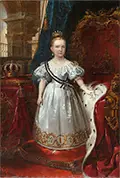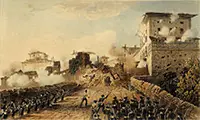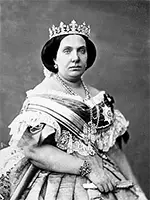Queen Isabella II of Spain
Isabella II was the ruling monarch of Spain for four decades in the second half of the 19th Century. Controversy marked the majority of her reign. She was born on Oct. 10, 1830, at the Royal Palace in Madrid. Her father was the reigning monarch, King Ferdinand VII, and her mother was Maria Christina of the Two Sicilies. A sister, María Luisa, came two years later. 
In his last days, Ferdinand had removed the Salic Law prohibition against a woman's inheriting a throne. Ferdinand died on Sept. 18, 1833. That same day saw the recognition of Spain's Queen Isabella II. Since Isabella was just 3, her mother became regent. 
One person who didn't take kindly to Isabella's rule was her uncle, Carlos (right), the Count of Molina. He considered himself the natural successor to his brother and had many supporters who agreed with him. In fact, those supporters took up arms to get their man on the Spanish throne. The First Carlist War (named after Carlos) lasted seven years and was as much a war over which person would sit on the throne as a philosophical struggle over what kind of government should have. Carlists wanted Carlos as a monarch more in the absolutist mode. Liberals wanted Isabella as a constitutional monarch, subject to some form of governmental oversight. After the war ended, in 1840, Queen Maria Christina abdicated as regent; taking over was a hero of the Crown's victory in the First Carlist War, Baldomero Espartero, Prince of Vergara. The new regent served just two years before a pair of other generals, Leopoldo O'Donnell and Ramón María Narváez, put together a cabinet, led by the writer Joaquín María López, who served as the equivalent of a prime minister. By this time, Isabella was 13, and the cabinet declared her to be of age to rule in her own right. A period of peace and reform ensued. Isabella married Francisco de Asís, Duke of Cádiz, in 1846. The choice of husband was not Isabella's. 
In that same year, another Carlist War began. Supporters of Carlos had wanted their man to marry the queen and take over the monarchy that way. The revolt lasted three years, ending once again in a victory for the Liberals and the Queen. The Revolutions of 1848 convulsed many other European powers, but Spain largely avoided such widespread change. The war was going on in that year, and the chance of a political uprising convinced the government to name Narváez as dictator for a time. Isabella II had a son, named Ferdinand, in 1850. He did not survive. She had a daughter, María Isabel, the following year. In 1852, the queen survived an assassination attempt. A priest named Martín Merino y Gómez stabbed Isabella II in the chest; however, her heavy clothes and gold embroidery blunted the impact of the stab wound. Authorities quickly apprehended the assailant, who was executed not long afterward. Another military takeover in 1854 provoked widespread unrest and uncertainty. Instigating the Vicalvarada was O'Donnell, who looked to produce more governmental reforms. Taking the coup as a pretext, a large number of people declared open revolt, forming large crowds in the streets of Madrid. The queen's appointing Espartero as prime minister helped appease those in rebellion, and her reign continued. Another coup, two years later, kept the queen in power but prevented the enactment of a new constitution. 
The queen had a son, Alfonso, in 1857. He survived childhood and became the heir apparent. Isabella had three more daughters: María del Pilar (1861), María de la Paz (1862), and María Eulalia (1864). The queen and her government had a mixed record in overseas wars, defeating Morocco in 1860 and gaining territorial positions but fighting Chile and Peru to a standstill in 1864–1866 (despite having an ironclad ship). Throughout most of her reign, Isabella had presided over periods of uncertainty. She had narrowly survived a rebellion led by General Juan Prim in 1866. By 1868, a majority of people had had enough of the chaos–the wars of succession, the military coups, the adoptions and then setting aside of a very new constitution, the switching of sides between conservative and liberal depending on what seemed like royal whims. On September 18, a large number of varying factions combined efforts to overthrow the queen, in what many sources refer to as the Glorious Revolution. Included in the angry multitude were two prominent generals, Prim and Francisco Serrano, and a large number of soldiers. The queen still had supporters, including some in the military, and a battle ensued, at Alcolea, on September 28. The victory that day went to the rebels, however, and the queen fled to France. Not long afterward, people in Cuba rose up against Spanish rule. The resulting Ten Years' War continued into the reign of the next monarch. A constitutional government came to power and held the reins while the Spanish people cast about for a new constitutional monarch. They finally decided to look outside their own borders, settling on an Italian prince, Amadeo of Savoy, a son of Victor Emannuel II of Italy. The reign of Amadeo I was two years, succeeded in earnest by the declaration of the First Spanish Republic. Even that failed to take hold (after a series of five presidents and two prime ministers, all who served only a short time), and another general, Arsenio Martínez Campos, led yet another coup, in December 1874. Adding to the unrest, supporters of the queen's uncle launched a third Carlist War, which dragged on for a few years more and finally ended the same way the first two had, with a Carlist defeat, after which Carlos left the country. Isabella's son, Alfonso, returned from exile in early 1875 and assumed the throne as King Alfonso XII. Historians refer to this in Spanish history as the Bourbon Restoration. Isabella returned for Spain the following year, but not at the head of an army. She returned to France after several months and lived in Paris thereafter. She died there, on April 9, 1904. |
|
Social Studies for Kids
copyright 2002–2024
David White




